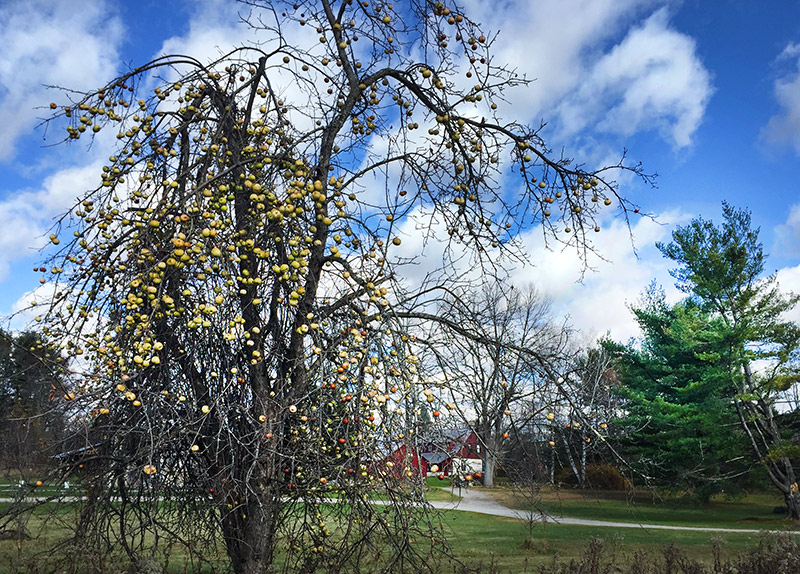
On October 23, 1920, Robert Frost wrote to a friend that he was about to move to “a stone cottage on a hill” in South Shaftsbury, Vermont, where “I mean to plant a new Garden of Eden with a thousand apple trees of some unforbidden variety.”
Just east of the Village of North Bennington, the old Peleg Cole farm was small, only about 90 acres. It included open pastures, an orchid-fringed wetland, a modest orchard, two barns and an 18th century house. Frost described the homestead as an “old stone (Paleolithic) house of some charm.” He enrolled his daugher Marjorie in North Bennington High School, and in December 1920 proceeded to make South Shaftsbury his base of operations.
In the 1920s, Frost was an acclaimed poet with a busy life of academic appointments, publishing commitments and readings. The Frosts’ son, Carol (together with his new wife, Lillian, from North Bennington) was principally responsible for farming operations, and Frost was often traveling. Robert Frost tended to be in residence during the summer and on holidays. Still, Frost took an active interest in the farm, planted trees, and helped with deliveries. Despite his fame, Frost was once peremptorily ordered to use a side door, at an inn in Bennington, when delivering an order of peas from the farm. Besides apples and vegetables, the farm also produced blueberries and flowers. Frost wrote a friend in 1925 that “I always so dreamed of being a real farmer; and seeing [Carol] one is almost the same as being one myself. My heart’s in it with him.”
In one astonishing night and morning at the farm in June 1922, Frost wrote both “New Hampshire” and “Stopping by Woods on a Snowy Evening.” Frost recalled years later that after writing “New Hampshire” through the night at a kitchen table, “I went outdoors, got out sideways and didn’t disturb anybody in the house, and about nine or ten o’clock went back in and wrote the piece about the snowy evening and the little horse as if I’d had an hallucination.” Frost’s walk started and ended on his farm, and might well have included a section of the trail described below.
Today, the farm is divided into two parcels, both open to the public. The house and five acres are owned by Bennington College and operated as The Robert Frost Stone House Museum. The house is also used in connection with the college’s literature program and for special events.
The rest of the property is owned by The Fund for North Bennington, Inc, and contains the Robert Frost Trail. When walking on the trail west to east — from Lake Paran to Route 7A — one enters the Frost farm property when turning into the woods, after walking along a row of old maples on the left and a pasture on the right. From that point to the parking area on Route 7A,the trail is located on Frost’s farm. After crossing the wetland and starting up a gentle hill, the trail follows an old farm road from Frost’s day, through the remains of a red pine grove planted by Frost, and then through the remains of his apple orchard. Most of the remaining apple trees are surrounded by woodland. The old pastures and orchard grove have largely reverted to woods over the years.
During the 1920s, Frost also rented the “Shingle Cottage” in North Bennington, now on the campus of Bennington College, for a year. The noise and commotion of family gatherings at the farm in South Shaftsbury strained Frost’s nerves, and he sought refuge in Shingle Cottage while still visiting the farm. Frost and his wife gave the South Shaftsbury farm to Carol and Lillian, and purchased a new farm near Buck’s Cobble in Shaftsbury—a place he first visited while on a walk in 1928. The Buck’s Cobble property is now owned by Norman Lear, the Hollywood producer.
Carol continued to farm the old Peleg Cole place through the 1930s, but apparently with ever-diminishing returns. Carol died by his own hand in 1940. Carol and Lillian are buried with Robert and Elinor Frost in the graveyard of the Old First Church, in Old Bennington.

Sources: Parini, Robert Frost, a Life (1999) 195, 206, 212-213, 223, 239, 260, 262-263, 331-332; Sheehy et al. (ed) The Letters of Robert Frost, Vol. 2 (2016), 103, 127, 416